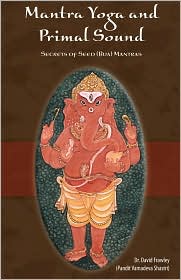
After many years of working with mantras, I’m aware of bija (seed) mantras and was seeking more information about them. One of my favorite mantras for Lakshmi, the Goddess of good fortune and domestic bliss, is “Om shrim klim maha Lakshmayei namaha.” I know that shrim and klim are bija mantras, but what exactly do they mean, and why are they associated with Lakshmi? So when I saw this book by noted Vedic astrologer David Frawley, I got it! Bonus! It turned out to be exactly what I was looking for on this topic.
Frawley gives a thorough, meticulous and well-written overview of this subject. The book starts with an examination of the many applications of mantra in Hindu, Tantric and Vedic practices, and gives an overview of the underlying philosophy of mantras. This is followed by insights on how bija mantras are derived from the Sanskrit alphabet. Frawley supplies a useful table dividing the Sanskrit alphabet into vowels and consonants, and then lists the many bija mantras and their meanings. Each bija is associated with a distinct deity, energy quality, and in some cases, a planet.
In Part II, the author explores how mantras can be applied to a variety of life purposes – some mundane, others spiritual. He describes Mantra Purusha, an Ayurvedic healing method; bija mantras are associated with specific body parts and organs. There are tips for applying this therapy, as well as for Mantra Nyasa – a ritual for consecrating one’s body to a deity.
Part III features an overview of other practices connected to bijas: healing and body balancing therapies, bijas associated with divine names of Hindu gods and goddesses, and additional Ayurvedic therapies to balance doshas and vital essences, astrological mantras that are used as remedies for problems in the natal chart, and directional bija mantras used in Vashtu (a Hindu version of Feng Shui). Material at the end of the book includesincludes appendices with Sanskrit pronunciation guide, the full set of mantras needed for performing Mantra Purusha/Nyasa, a glossary, bibliography, resources, and endnotes.
This small book is densely packed with history, lore and more mantras! It would be very helpful for anyone who wants to know more about how mantras work and how particular bits and pieces get linked together (without having to learn Sanskrit). The material is well organized and presented in a thoughtful, reverent manner. The only mild criticism is that the book is formatted in a medium-size font with tight line spacing and very slim margins, so there’s very little white space on the page. So it’s a bit hard on the eyes.
For mantra aficionados like me, this book is a prize because it fills in gaps left in layman-friendly mantra books like those by Thomas Ashley-Farrand (“Healing Mantras,” “Chakhra Mantras” and similar, quite accessible for beginners). Some previous reading in Hindu-oriented texts or familiarity with Sanskrit terminology would be very helpful, as this book targets a more intermediate or advanced reader with a background in these subjects. Highly recommended – it fills a much-needed niche in the English mantra books category.
~Review by Elizabeth Hazel
Author: Dr. David Frawley
Lotus Press, 2010
196 pp. $14.95.
